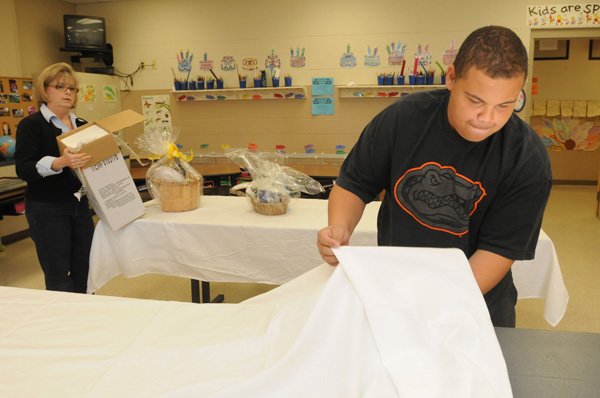Black Population In Area Cities
City // 2008 // 2009
Fayetteville // 7.3 percent // 7.4 percent
Bentonville // 2.8 percent // 4.5 percent
Rogers // 1 percent // 1.1 percent
Springdale // 0.9 percent // 1.8 percent
FAYETTEVILLE — Most early blacks residents of Northwest Arkansas came unwillingly, as slaves. After the Civil War, many left for better opportunities or were forced out. Now, more than 150 years later, jobs, educational opportunities and lifestyle are drawing blacks to the area.
"There was a substantial black population in the hills," said Melba Smith, a Fayetteville native and president of the Northwest Arkansas African American Heritage Association. "I had relatives who were here in the mid-1840s."
The black population in the four largest cities in Washington and Benton counties grew from 2008 to 2009 but is about half the size of the Hispanic population, which declined slightly.
Nationally, blacks make up about 13 percent of the population, according to the U.S. Census Bureau. Census estimates released this month show Fayetteville had the largest black population in 2009 of any area city at 7.5 percent.
Members of the Northwest Arkansas African-American Heritage Association were instrumental in locating, cleaning up and documenting a neglected African-American burial site in the Baldwin community east of Fayetteville that dates at least to the 1880s. The group also documents the experiences of older residents and is using its work to educate a younger generation.
"I think it's important to involve the kids because it informs them about who they are themselves," said Sharon Killian, the association's vice president. "They have another thread to the earth, another thread to the United States, another thread to Fayetteville, another thread to their grandparents."
Change Comes Slowly
Slaves came with the initial wave of settlers in the 1820s and contributed to the basic building of the community, according to the "History of Washington County." The first Washington County Census, in 1829, found 744 whites and 89 black slaves, 10 percent of the population. They were owned by 20 of the county's white families. By 1860, there were 1,493 slaves in the county, still about 10 percent to 12 percent of the population.
"Slavery was practiced in Northwest Arkansas," said Tom Dillard, head of special collections at the University of Arkansas. "There's a general recognition that it was not nearly as common here as it was in the plantation counties. A farm in Washington County in 1850, the farmer, on average, is not going to have a slave, but there certainly were groups of slaves here."
After the war, many former slaves remained in Northwest Arkansas. One group of former slaves lived in the Cane Hill area well into the 20th century. Others migrated to Fayetteville and surrounding areas.
"As time went by, there was also what is called today racial cleansing," Dillard said. "Towns like Eureka Springs evicted its black residents, but it wasn't limited to Eureka Springs. It played out in many other towns, too. Harrison was one."
During the early 20th century and the Depression, many blacks left. Some went north looking for jobs.
"They moved from Northwest Arkansas for many of the same reasons probably that some black people feel uncomfortable here today," Dillard said, "and that is that it was such a lopsided minority, and economic opportunities were not there."
Things did improve for blacks in Northwest Arkansas after World War II, largely because of educational opportunities, local experts said.
Silas Hunt, a military veteran, was admitted to the University of Arkansas School of Law in 1948. Hunt became the first black student to be admitted since Reconstruction and the first black student to be admitted for graduate or professional studies at any all-white Southern university. Today, the law school's dean is a black woman, Cyndi Nance, and the admissions building is named after Hunt.
In 1954, Fayetteville quietly integrated its high school and junior high schools, three years before the Central High crisis in Little Roc focused national attention on the state. On Sept. 10, 1954, five black students entered Fayetteville High School. A few days later two more entered.
The only male black student to enroll in classes on Sept. 10, Preston Lackey, entered with the support of white students who had heard rumors of planned violence, according to the "Encyclopedia of Arkansas." The only opposition was a white woman with a placard.
Fayetteville completed integration of the elementary schools in 1965.
Today, the black population, while still small, is a mix of the descendants of those blacks who stayed, such as Jessie Bryant and Melba Smith, and an infusion of those who moved to the area because of the university, including law school dean Cyndi Nance, or to take advantage of area's economy and quality of life, like Fayetteville Police Department Det. Tim Franklin.
"Northwest Arkansas has changed because now they listen," Bryant said. "Everybody is somebody."

